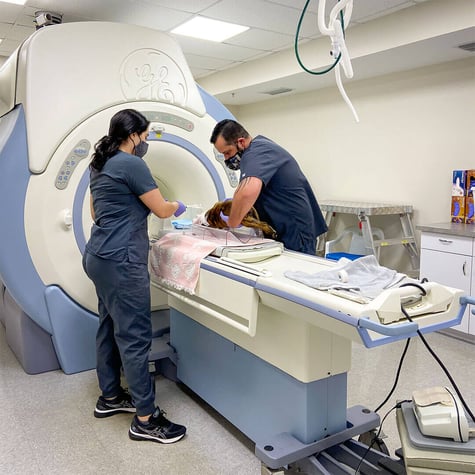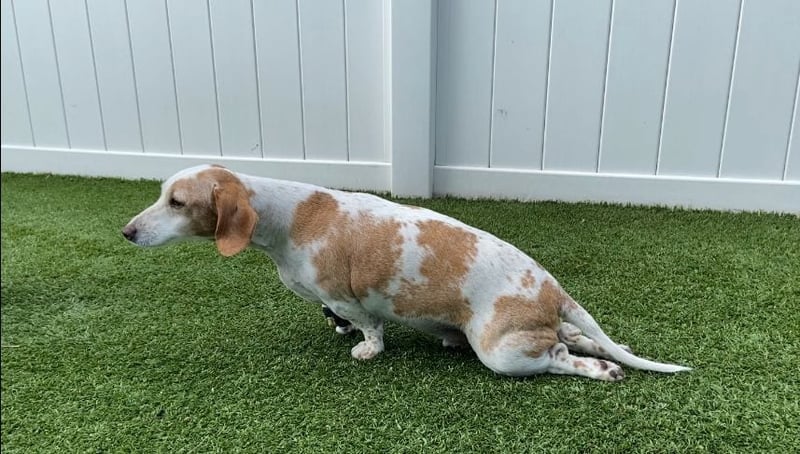Intervertebral Disc Disease (IVDD) in Dogs
Home » Conditions We Treat » Intervertebral Disc Disease (IVDD) in Dogs
What is intervertebral disc disease?
Rare in cats, intervertebral disc disease (IVDD) is a common cause of spinal pain, inability to walk, and rear limb paralysis in dogs. IVDD can occur in any dog, but mostly affects Dachshunds, French Bulldogs, Shih Tzus, Pekingese, and Beagles.
This condition is often described as a slipped disc, ruptured disc, herniated disc, or bulging disc. Intervertebral discs are structures between the bones of the spinal column (vertebrae) that act as shock absorbers and allow the spine to bend. They consist of a soft gel-like center (nucleus pulposus) and an outer fibrous layer (annulus fibrosus).
Whether due to a spinal injury or breed abnormality, the soft center of the intervertebral disc can dry out and turn brittle, rupture through the fibrous exterior, and push on the spinal cord. This may cause pain, limited mobility, and even paralysis. At Southeast Veterinary Neurology (SEVN), our veterinary neurologists are highly experienced in treating IVDD and available to help you and your pet. Download the fact sheet.
Time is of the essence. If your pet has any of the symptoms listed below, these can lead to irreversible damage. Please call us immediately.
Symptoms of IVDD
Intervertebral discs run the length of the vertebral column. IVDD can occur in the neck (cervical region), middle back (thoracolumbar region), and lower back (lumbosacral region). On this page, we focus on the back.
The symptoms you see in your pet can help us determine the severity of their condition. Once a pet has lost the ability to walk, it is a neurological emergency.
Symptoms of thoracolumbar IVDD are graded on the following scale of 1-5. Click each grade for a detailed explanation.
- Able to walk normally
- Exhibiting signs of back pain such as not wanting to jump or move, shivering, walking slowly or gingerly, crying, shivering, muscle spasms, arching the back, or a tense belly
- Still able to walk, but weak and wobbly in rear limbs
- May cross, splay out, or stumble over back legs or walk with back paws knuckled under
- Too weak in rear limbs to stand or walk
- Still able to move limbs and wag tail
- Cannot stand or walk
- Cannot move rear limbs
- Still able to feel toes
- Cannot stand or walk
- Cannot move rear limbs
- Cannot feel rear limbs at all
Symptoms of lumbosacral IVDD include:
- Pain and difficulty jumping
- A limp tail
- Urinary or fecal incontinence
- Dilated anus

How We Diagnose IVDD

Other diseases can cause similar clinical signs including meningitis/myelitis, spinal tumors, trauma, infection, malformations, and vascular problems. The neurological exam and advanced imaging help us achieve the most accurate diagnosis.
- Neurological exam. Our vet neurologists have years of experience and training in recognizing signs of a neurological problem in pet patients and working to narrow down the possible causes.
- Magnetic Resonance Imaging (MRI). MRI is the best way to visualize the spinal cord and determine for certain that a patient is living with IVDD, versus another neurological disorder with similar signs.
What is my pet's prognosis?
There are several factors that will determine your pet's prognosis and likelihood of walking again:
- The severity of symptoms
- How quickly the signs appeared
- How much compression there is on the spinal cord
- How quickly one of our neurologists can address the problem
- The treatment option elected
Intervertebral Disc Disease Treatment Options
Without timely treatment, IVDD can progress quickly and cause irreversible damage. Therefore, your pet should be evaluated by our team as soon as you notice any signs of back pain and difficulty walking. There are two basic ways to treat IVDD in dogs:
For patients with first-time back pain or mild weakness, we can try a medical approach that includes pain medication and strict crate rest for at least four weeks. We also use this approach if the patient cannot undergo MRI due either to owner preference or concurrent medical conditions.
Your pet can come out of the cage for urination, defecation, and physical rehabilitation, but should otherwise be crate rested.
For dogs with grades 1-4 IVDD that are managed non-surgically, the chances of making a fully functional recovery are about 50-70%, depending on the degree of neurological symptoms. They may take longer to improve, have a higher risk for recurrence, and are at greater risk for worsening when compared to those that are treated with surgery.
Grade 5 is a surgical emergency.
If the patient is experiencing difficulty walking or has recurrent or persistent back pain that will not respond to rest or medication, surgery may be the best option. The goal is to remove the disc material that is pressing on the spinal cord. We can also do a preventative procedure at this time to reduce the likelihood of recurrence.
For dogs with grades 1-4 IVDD that are managed surgically, the chances of making a fully functional recovery are about 95% in the hands of an experienced neurosurgeon at SEVN.
For grade 5 dogs, the chances of recovery are significantly lower at about 50%. Surgery should be performed as soon as possible for the best chance of recovery, no more than 48 hours after losing the ability to feel the legs.
Unfortunately, with or without surgery, dogs with grade 5 IVDD are at risk for myelomalacia, an extremely serious condition that is typically progressive and fatal.


